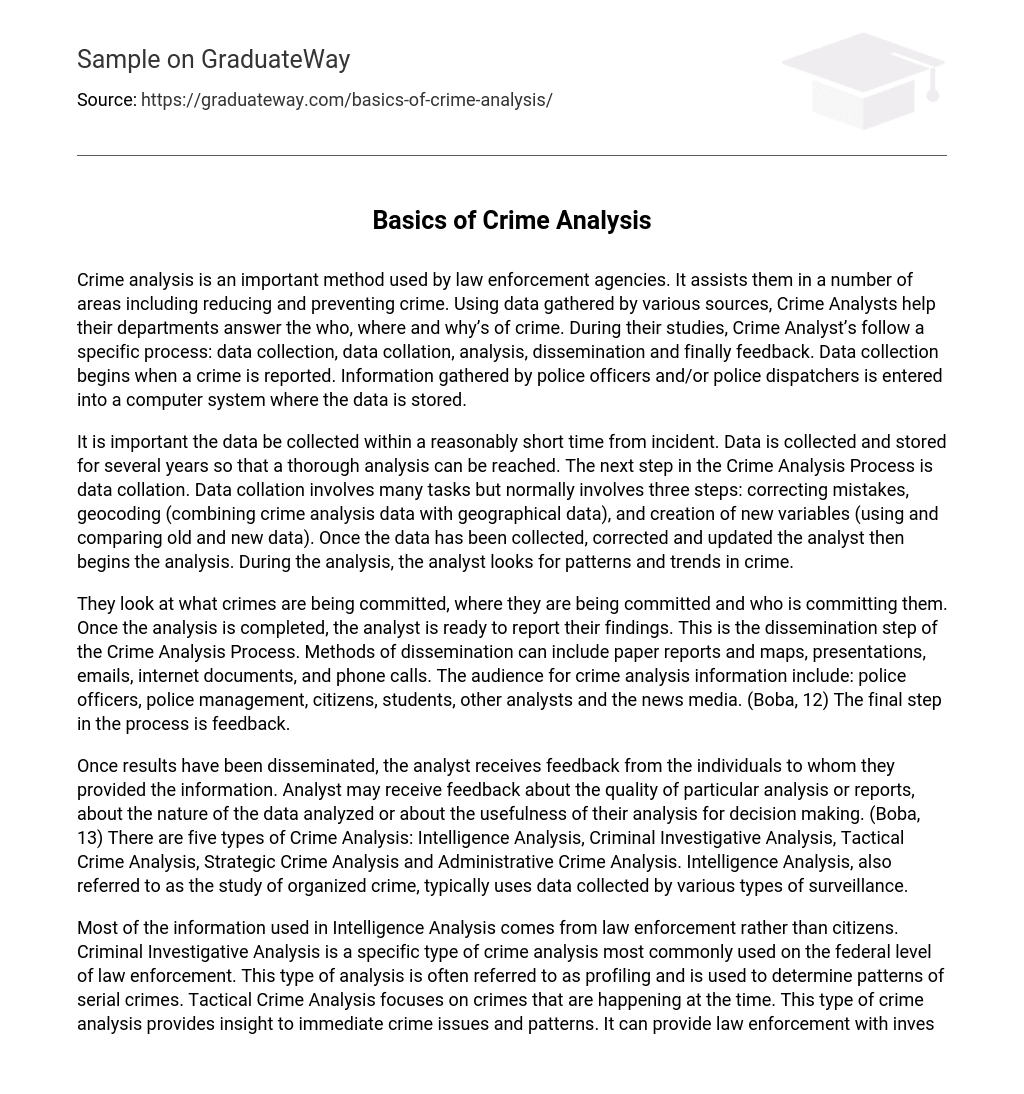Crime analysis is an important method used by law enforcement agencies. It assists them in a number of areas including reducing and preventing crime. Using data gathered by various sources, Crime Analysts help their departments answer the who, where and why’s of crime. During their studies, Crime Analyst’s follow a specific process: data collection, data collation, analysis, dissemination and finally feedback. Data collection begins when a crime is reported. Information gathered by police officers and/or police dispatchers is entered into a computer system where the data is stored.
It is important the data be collected within a reasonably short time from incident. Data is collected and stored for several years so that a thorough analysis can be reached. The next step in the Crime Analysis Process is data collation. Data collation involves many tasks but normally involves three steps: correcting mistakes, geocoding (combining crime analysis data with geographical data), and creation of new variables (using and comparing old and new data). Once the data has been collected, corrected and updated the analyst then begins the analysis. During the analysis, the analyst looks for patterns and trends in crime.
They look at what crimes are being committed, where they are being committed and who is committing them. Once the analysis is completed, the analyst is ready to report their findings. This is the dissemination step of the Crime Analysis Process. Methods of dissemination can include paper reports and maps, presentations, emails, internet documents, and phone calls. The audience for crime analysis information include: police officers, police management, citizens, students, other analysts and the news media. (Boba, 12) The final step in the process is feedback.
Once results have been disseminated, the analyst receives feedback from the individuals to whom they provided the information. Analyst may receive feedback about the quality of particular analysis or reports, about the nature of the data analyzed or about the usefulness of their analysis for decision making. (Boba, 13) There are five types of Crime Analysis: Intelligence Analysis, Criminal Investigative Analysis, Tactical Crime Analysis, Strategic Crime Analysis and Administrative Crime Analysis. Intelligence Analysis, also referred to as the study of organized crime, typically uses data collected by various types of surveillance.
Most of the information used in Intelligence Analysis comes from law enforcement rather than citizens. Criminal Investigative Analysis is a specific type of crime analysis most commonly used on the federal level of law enforcement. This type of analysis is often referred to as profiling and is used to determine patterns of serial crimes. Tactical Crime Analysis focuses on crimes that are happening at the time. This type of crime analysis provides insight to immediate crime issues and patterns. It can provide law enforcement with investigative leads and insight to where crime is happening.
This type of analysis compares criminal activity, time, date, location and other types of information. Strategic Crime Analysis is the study of crime problems and other police-related issues to determine long-term patterns of activity as well as to evaluate police responses and organizational procedures. The findings of strategic crime analysts’ research and evaluation of police responses to crime problems assist police agencies in assessing their effectiveness. Strategic Crime Analysis is sometimes referred to as operational analysis because it deals with the operations of police agencies and not the nature of crime problems and patterns. Boba, 15) Administrative Crime Analysis is different from other types of crime analysis. The main focus of Administrative Crime Analysis is deciding what information to present and how to present it. Goals of Crime Analysis include: apprehending criminals, preventing crime, reducing disorder and evaluating organizational procedures. The main goal of Crime Analysis is to apprehend criminals. With the help of crime analyst, law enforcement officers have access to a database of information on known criminals.
When a crime is reported a crime analyst may be able to tell officers if there is a known offender in the area that fits the description of the subject they are trying to find. Another goal of Crime Analysis is preventing crime. Through data collected and stored, analyst are able to tell law enforcement officers where, as well as, what crimes are happening and the time of day the crime most frequently occur. Such information can help agencies determine where they need to be patrolling, when they need to be patrolling and also the number of officers needed in a specific area.
The third goal of crime analysis is to reduce disorder. Crime analysis can assist with these efforts by providing research and analysis of disorder indicators such as traffic accidents, noise complaints, or trespass warnings that can assist officers in addressing these issues before they become a more serious problem. (Boba, 11) The fourth goal of crime analysis is to evaluate organizational procedures. Analysts use data to determine the effectiveness of the law enforcement agency. They can also determine staffing needs.





